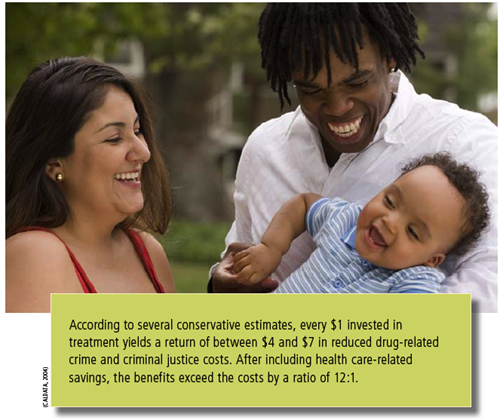

Alcohol and other drug problems are concerns of the public health and justice systems, including the criminal, civil, and juvenile branches. The impact of alcohol and other drug problems in the justice system are not limited to cases involving drug-related offenses. Alcohol and other drug problems compound many of the complex issues the justice systems handle every day, including assault, vandalism, child abuse, and divorce.
While most attempts to decrease the number of drug-related offenses have often solely emphasized drug interdiction and incarceration, research has shown that they have had minimal—if any—impact on decreasing substance abuse or the violence associated with criminal activity by individuals with alcohol and other drug problems (Marlowe, 2002).
Effectively addressing problems requires an integrated public health and public safety approach. Treatment decreases drug problems, crime, and recidivism while improving health conditions. Treatment also saves money, and in today’s climate of growing fiscal constraints, it is imperative to re-evaluate spending priorities. Alcohol and other drug problems place a huge burden on our economy—resulting in high health care costs, productivity losses, and other expenses associated with crime and accidents (Belenko et al., 2005). A large portion of this economic burden falls on state justice systems (Join Together, 2006).
If treatment costs less and works better, why have only about 18% (4 million) of the 22.6 million Americans with substance use problems received treatment (SAMSHA, 2007)? In addition to the reluctance to seek treatment by those who need it, the general public, including health professionals, have a lack of knowledge about the effectiveness of treatment and are concerned about the difficulty identifying and accessing appropriate services (Compton et al., 2007). Therefore, educating the justice system about the complexities of handling alcohol and other drugs and the need for scientifically proven approaches is particularly important since the justice system is often society’s first and, many times, only opportunity to identify individuals with substance use disorders. As a result, judges, lawyers, probation and parole officers, and other court personnel are uniquely positioned to link these individuals to health professionals, treatment programs, mutual-help groups, local specialty treatment courts, and other related resources.

Over the past 20 years, the justice system has re-examined the way it handles individuals with alcohol and other drug problems by using an innovative approach called therapeutic jurisprudence (Wexler, 1990; Hora et al., 1999). This approach focuses on the concept that the justice system can and should identify and address legal problems in ways that are therapeutic and holistic—encompassing a wide range of issues experienced by individuals with alcohol and other drug problems, including medical and social problems. Problem-solving courts, like drug courts, provide an example of an effective, integrated approach that grew out of therapeutic jurisprudence. However, because of the pervasiveness of substance problems, this guide is not only intended to educate already established systems, but also assist in the development and implementation of integrated approaches throughout and beyond the justice system.










